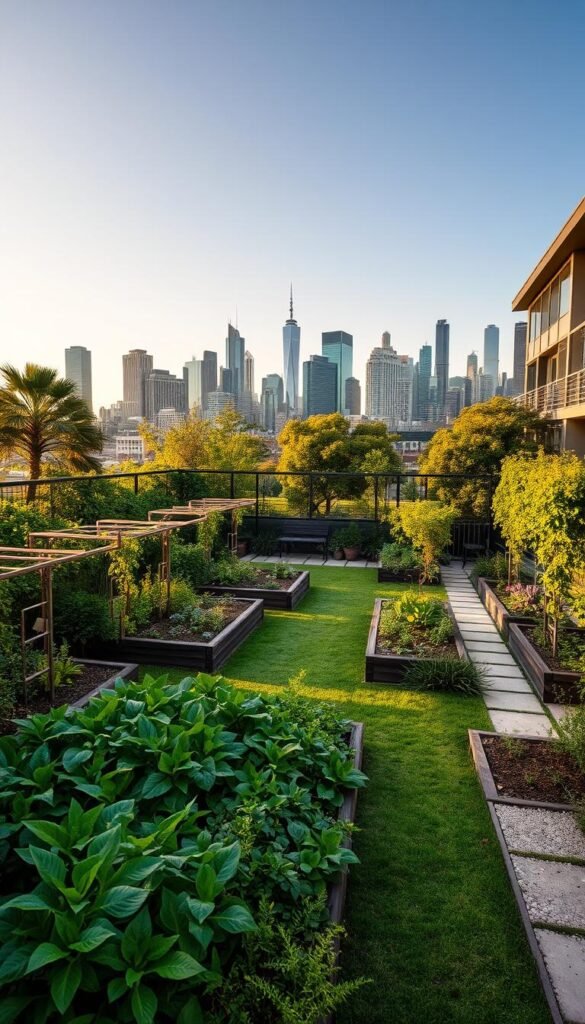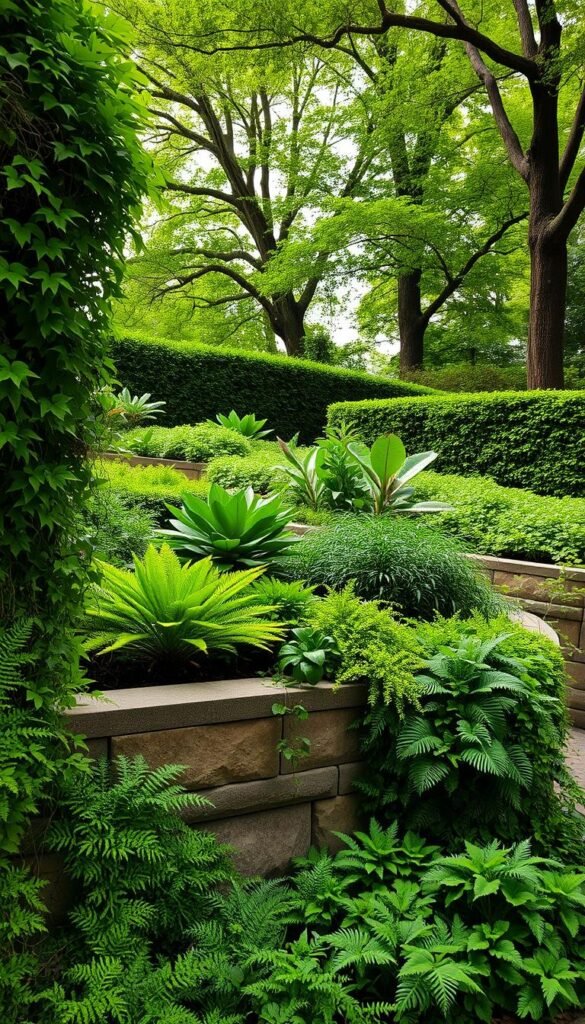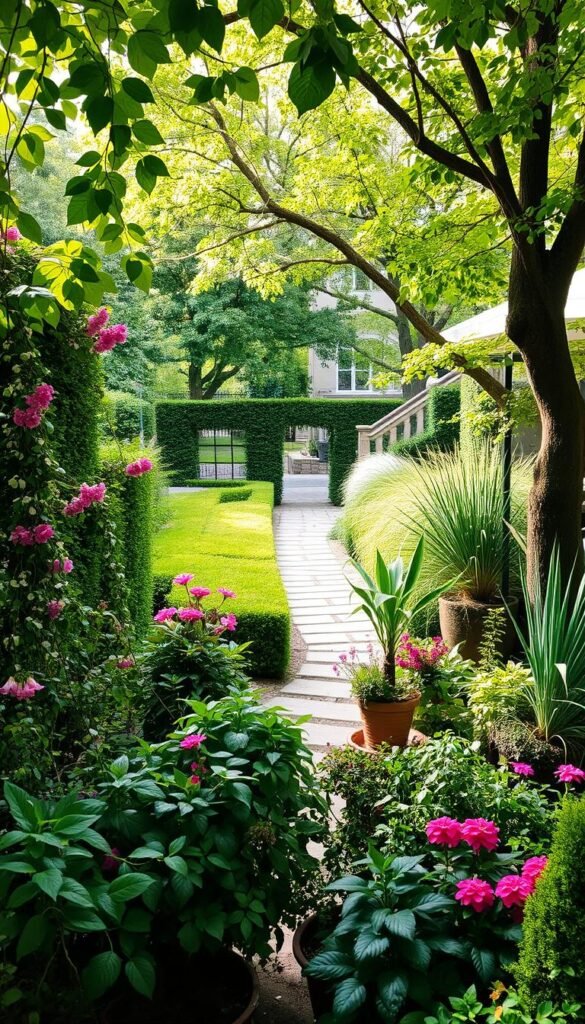Imagine stepping outside your door into a lush green retreat that feels miles away from busy streets. With smart planning, even cramped spaces can become vibrant escapes bursting with life. Whether you have a balcony, rooftop, or sliver of backyard, growing plants in metro areas offers fresh food, cleaner air, and a personal sanctuary.
One passionate grower turned a cramped L-shaped lot beneath an aging cherry tree into a thriving green haven over two decades. Their story proves how creativity and patience can reshape neglected corners into living masterpieces. You’ll see how small changes create big impacts—for your plate, wallet, and community.
Why are so many city residents embracing this trend? Beyond the joy of homegrown tomatoes, nurturing plants reduces stress while cutting grocery costs. Shared plots foster friendships, and every leaf helps filter pollution. Even compact setups support bees and butterflies, making your slice of nature part of something bigger.
Ready to transform your space? This guide breaks down practical steps to maximize what you have. From choosing hardy plants to arranging layouts that save room, you’ll learn how to build a peaceful escape that works with your lifestyle—not against it.
Embracing the Urban Gardening Lifestyle
Picture this: your morning coffee enjoyed beside thriving plants that nourish your body and soul. This isn’t just about growing greens—it’s a movement reshaping how we interact with our surroundings. Let’s explore how cultivating plants in metro areas creates ripples of positive change.
Discovering the Benefits of an Urban Oasis
Your balcony or windowsill can become a source of crisp salads and herbal teas. By growing food at home, you skip supermarket chemicals while saving money. One tomato plant yields 10-15 pounds of fruit each season—imagine that multiplied across herbs, peppers, and leafy greens!
These green spaces do more than feed you. They act as natural air filters, absorbing car exhaust and cooling hot pavements. A single square meter of greenery removes 200 grams of dust annually from city air.
How Gardens Enhance City Living
Beyond fresh meals and cleaner skies, these spaces build community. Join local plant swaps or teach kids how seeds become snacks. Many growers find unexpected friendships while trading zucchini for homemade jam.
Your personal Eden also becomes a mental reset button. Studies show just 20 minutes among plants lowers stress hormones. Those basil plants? They’re doubling as aromatherapy stations.
Whether you’re growing microgreens or moonflowers, every leaf makes your corner of the city healthier and happier. Ready to dig deeper? Let’s assess your unique space next.
Understanding and Assessing Your Space

Transforming a tiny corner into a lush retreat starts with knowing your environment. Let’s break down the three pillars of success: sunlight, soil quality, and smart layouts. You’ll learn to work with what you have—not against it.
Evaluating Sunlight, Soil, and Space Constraints
Start by tracking how light moves through your area. Most edibles need 6+ hours of direct sun daily. Use a free app like SunSeeker or simply note shadows every two hours. No south-facing windows? Leafy greens like spinach often thrive in partial shade.
Next, test your soil’s pH and nutrients. Kits from local nurseries or online retailers make this easy. “The right spot can turn struggling plants into thriving ones,” says Maria Gonzalez, a Brooklyn-based gardener. Aim for pH levels between 6.0-7.0 for vegetables—add lime to raise acidity or sulfur to lower it.
| Space Type | Sunlight Tips | Soil Solutions |
|---|---|---|
| Rooftops | Watch for wind exposure | Use lightweight potting mix |
| Balconies | Measure railings’ shade patterns | Add compost to store-bought soil |
| Small Yards | Note tree canopy changes | Test for lead if near old buildings |
Limited square footage? Think upward! Trellises for peas or wall-mounted planters save floor space. For container setups, ensure proper drainage and rotate pots weekly for even sun distribution. Even fire escapes can host herbs—just check local regulations first.
Urban Garden Design Tactics: Crafting an Oasis in the City

Transform your space into a living masterpiece using nature’s own brushstrokes. Start by building a lush green screen with fast-growing options like Leyland cypress or rhododendrons. These living walls filter street noise while giving your favorite plants a dramatic stage to shine.
Focus on leaves before blooms for year-round beauty. Mix spiky yucca leaves with round hostas or velvety lamb’s ear. “Texture creates depth even in small spaces,” notes landscape architect Emma Park. This approach keeps your serene garden retreat visually engaging through all seasons.
Create rhythm through repeating patterns:
- Line pathways with flowing Japanese forest grass
- Cluster three matching pots of ornamental cabbage
- Alternate silver-dollar eucalyptus with purple sage
Turn challenges into features. Under mature trees, plant shallow-rooted epimediums that thrive in dry shade. Pair their heart-shaped leaves with the striking white edges of ‘Wolf Eyes’ dogwood for instant contrast. These smart solutions help you craft a personalized sanctuary that feels both intentional and effortless.
Choosing the Right Plants for Your Urban Sanctuary

Your plant choices can turn even the smallest balcony into a productive paradise. Matching greenery to your light conditions and space limitations ensures lush growth without constant fuss. Let’s explore smart picks that deliver flavor, color, and cleaner air.
Sun-Loving vs. Shade-Tolerant Options
Tomatoes demand 6-8 hours of direct light. Pair them with marigolds—their bright flowers repel pests while adding cheer. For shady corners, try pansies or lettuce. These thrive with just 3-4 hours of morning sun.
Use this quick guide to match plants to your setup:
| Light Conditions | Top Picks | Bonus Features |
|---|---|---|
| Full Sun | Sunflowers, rosemary | Attract pollinators |
| Partial Shade | Spinach, hostas | Cool-season harvests |
| Low Light | Snake plants, mint | Purify indoor air |
Herbs, Edibles, and Foliage-First Selections
Basil and thyme flourish in pots near kitchen windows. Snip fresh leaves for meals while enjoying their invigorating scents. Compact veggies like peppers yield surprising harvests—one plant can produce 15-20 fruits!
Don’t overlook air-cleaning champions. Spider plants remove formaldehyde, and aloe vera soothes burns. “These green allies work overtime,” notes plant expert Lisa Nguyen. “They beautify spaces while boosting your health.”
Mix practical picks with visual stars. Radishes grow fast between ornamental grasses, and parsley’s ruffled leaves complement petunias. With smart pairings, every inch becomes both useful and eye-catching.
Designing with Vertical Gardens and Containers

Elevate your greenery game by thinking upward, not outward. Vertical gardening turns blank walls and cramped corners into thriving ecosystems. Paired with clever containers, these methods let you grow more in less space while adding artistic flair.
Vertical Gardening Benefits
Climbing plants like ivy or passionflower transform fences into living curtains. Trellises support peas and beans, while pocket planters host strawberries or succulents. “Vertical setups improve air circulation,” explains gardener Marco Torres. “They reduce mold risks and let leaves breathe easier.”
Hanging baskets with trailing petunias or sweet potato vines add color at eye level. Wall-mounted systems using recycled pallets or modular panels maximize every inch. These designs also block street noise and create shady retreats on sunny balconies.
Container Solutions for Limited Space
Terra cotta pots keep herbs like basil within arm’s reach of your kitchen. For veggies, try fabric grow bags—their porous walls prevent soggy roots. Pair them with colorful container flowers for instant cheer.
| Method | Best For | Examples |
|---|---|---|
| Vertical Gardening | Privacy screens | Trailing jasmine, wall ferns |
| Container Gardening | Herbs & compact crops | Fabric pots, self-watering boxes |
Mix sizes and heights for visual drama. Tall planters of dwarf citrus trees flank shorter pots of thyme and oregano. Rotate containers weekly so all sides get equal light. With these strategies, even fire escapes become lush, productive zones.
Maximizing Hardscape Elements and Creative Features

Your outdoor area becomes an extension of your living space when you blend stone, water, and greenery. Hardscaping creates structure while letting plants shine. A brick patio might frame your seating zone, while winding gravel paths invite exploration of hidden corners.
Patios, Paths, and Water Features
Start with a patio that mirrors your home’s style. Flagstone slabs offer rustic charm, while concrete pavers suit modern aesthetics. Keep it cozy with bistro chairs or build a dining zone under string lights. “These surfaces anchor your layout,” says landscaper Clara Ruiz. “They’re stages for both relaxation and gatherings.”
Pathways do more than connect points—they shape how you experience your garden. Use wide stepping stones to slow movement through fragrant herbs. Narrow gravel trails heighten anticipation around bends. For tight spaces, diagonal patterns make areas feel larger.
Add a water element to soften urban clamor. A tabletop fountain bubbles quietly beside ferns, while a recirculating pond attracts dragonflies. These features mask traffic sounds with nature’s soundtrack. Even a shallow birdbath becomes a drinking spot for sparrows.
Balance is key. Limit paved zones to 30% of your total area. Pair stone benches with billowing ornamental grasses, or let ivy cascade over retaining walls. Your hardscape should frame—not replace—the living greenery that makes your sanctuary thrive.
Maintenance Tips to Keep Your Oasis Thriving
Your green haven needs consistent care to flourish. Start with deep watering sessions every 2-3 days—soak roots thoroughly instead of light daily sprinkles. This builds drought resilience, especially in concrete-heavy areas where heat radiates faster.
Prune strategically to boost productivity. Trim dead leaves weekly and pinch herb tips to encourage bushier growth. “Sharp shears prevent disease spread,” advises Portland gardener Ryan Carter. Wipe blades with rubbing alcohol after each use for extra protection.
Feed your soil monthly with organic compost or worm castings. These natural fertilizers release nutrients slowly without chemical runoff. Test pH levels seasonally—most plants thrive between 6.0-7.0.
| Task | Frequency | Tool |
|---|---|---|
| Deep Watering | Every 3 days | Soaker hose |
| Nutrient Boost | Monthly | Compost tea |
| Pest Check | Weekly | Magnifying glass |
Spot trouble early by inspecting leaf undersides during morning checks. Neem oil tackles aphids safely, while crushed eggshells deter slugs. Wipe soot from leaves near busy streets using damp cloths—this helps plants breathe easier.
Adapt these tips to your microclimate. Rooftop gardens might need windbreaks, while shaded balconies benefit from reflective mulch. With smart adjustments, your gardening efforts yield lush results year-round.
Setting the Mood: Lighting and Ambiance Ideas
Transform your outdoor space into a twilight paradise with clever lighting strategies. The right illumination turns daytime greenery into an evening sanctuary where fireflies compete with your creative sparkle. Let’s explore how to layer brightness for both beauty and practicality.
Ambient and Motion Sensor Lighting Techniques
String lights draped over pergolas create starry ceilings above seating areas. Solar-powered lanterns placed along pathways glow softly after sunset, charging by day to shine at night. For drama, angle spotlights at textured bark or sculptural foliage—this casts shadows that dance in the breeze.
Motion-activated fixtures offer safety without harsh glare. Install them near entryways or steps to guide guests while conserving energy. “Layered lighting adapts to your needs,” notes designer Clara Mendez. “It’s about balancing aesthetics with smart function.”
| Type | Best Use | Power Source |
|---|---|---|
| Fairy Lights | Wrapped around trees | Solar/Battery |
| Path Lights | Edging walkways | Solar |
| Spotlights | Highlighting features | Low-voltage |
Pair subtle fairy lights with reflective surfaces like water features or metallic planters. This amplifies their glow while adding whimsy. For modern flair, try LED strips under benches—they outline shapes without overwhelming the space.
Remember: warm white tones (2700K-3000K) feel inviting, while cool whites suit contemporary designs. Adjust brightness based on your area’s natural light levels. With these techniques, your nighttime retreat becomes as captivating as its daytime version.
Adopting Sustainable and Eco-Friendly Gardening Practices
Turn your green space into a force for positive change through mindful gardening choices. Every organic tomato grown or rainwater barrel installed helps shrink your environmental footprint while boosting your neighborhood’s air quality.
Start by converting kitchen scraps into black gold. A simple compost bin transforms coffee grounds and fallen leaves into nutrient-rich soil. “This cycle cuts landfill waste while feeding your plants naturally,” explains urban farmer Diego Martinez. Pair this with creative vertical gardening ideas to maximize small spaces sustainably.
Save water smartly. Install rain barrels under downspouts—they collect free hydration for dry days. Drip irrigation systems deliver moisture straight to roots, reducing evaporation. Drought-loving lavender and sage thrive with minimal watering, keeping your garden lush without waste.
Choose native plants like milkweed or coneflowers. These local heroes need fewer pesticides and attract pollinators. Your yard becomes a safe haven for butterflies while improving air quality through natural filtration.
This way of gardening creates ripples beyond your plot. You’ll grow fresher meals, support ecosystems, and inspire neighbors—all while crafting a healthier urban garden ecosystem.
Incorporating Artistry and Personalized Touches
Your green retreat becomes truly yours when infused with pieces that spark joy. Think beyond plants—sculptures, mosaics, or hand-painted stones add character. Mix materials like weathered wood and polished metal to create layers of interest that catch the eye from every angle.
Using Architectural Elements and Garden Sculptures
Arches draped in climbing roses frame views, while a stone bench tucked under a trellis invites quiet moments. Place a ceramic bird bath amid lavender—it becomes both decor and a watering hole for sparrows. These features blend function with artistry, turning ordinary corners into destinations.
Repurposed items add whimsy. Hang vintage lanterns filled with trailing ivy, or stack painted tires as quirky planters. Solar-powered lights nestled among hostas cast soft glows on mosaic stepping stones at dusk. Every choice reflects your story, making the garden feel like an extension of your home.
For inspiration, explore ways to elevate your space with artistic accents that reflect your personality. A rusted iron wind spinner becomes a kinetic sculpture, while grouped succulents in colorful pots create living rainbows. Let your room outdoors evolve as you discover new ways to weave magic into its fabric.






